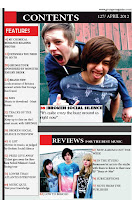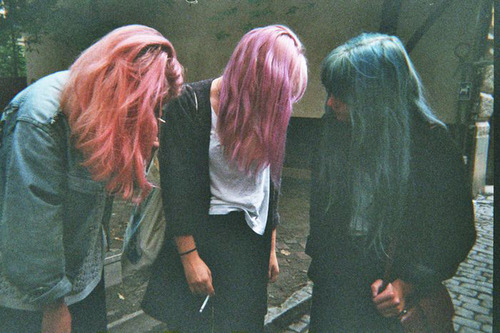ROCK GRUNGE BAND BROKEN SOCIAL SILENCE ALMOST SEEMED TO BECOME FAMOUS OVERNIGHT. HERE IN THE UK THEY HAVE BECOME A HOUSEHOLD NAME FOR TEENAGERS AND ADULTS ALIKE. SOON TO BE RELEASING THEIR SECOND ALBUM ‘ANOTHER STORY HIGH’ WE TALK WITH FRONT MAN GAWAIN POPE ABOUT HIS NEW FOUND FAME AND BAND LIFE IN THIS EXCLUSIVE INTERVIEW.
Broken Social Silence burst onto the music scene back in 2010 and have been heading nowhere but up ever since. From amateur Internet videos to international tours, Broken Social Suicide seemed to appear overnight.
After releasing their first single ‘Low to Behold’ back in 2010 they were soon nominated for the Teen Spirit Award for Best British Newcomer and Rising Star.
Soon after they supported You Me At Six, Mayday Parade and We The Kings. Six months later, the band released their debut album, Age of Understatement, in 2011 and headed out on a headline tour in Britain.
They have been making their way round the festivals this year and will be heading out to Reading and Leeds for most of August before returning to the studio to work on new material.
Born in the busy city of Cardiff, South Wales, Gawain found his love for music at the age of twelve when his father bought him the album ‘Nevermind’ by 90’s grunge band legends Nirvana. He found he could relate to the lyrics in the songs and this was what fuelled his passion for music. Soon after he began playing the guitar and participated in school talent shows. By the age of fifteen he formed ‘Broken Social Silence’ with band members Jordan and Rain. Two years on they were signed to Atlantic Records who produced their first single and later their first album.
Grunge Magazine caught up with Broken Social Silence's front man Gawain after practise. Here’s what he had to say.
How does it feel to be on the front cover of Grunge this week?
“It’s quite crazy the buzz around us right now. We’re not what you’d call a High Street band but on our next tour we’re suddenly playing for 10,000 and 20,000 capacity venues. We still think of ourselves as up and coming on the underground scene but it looks like the words getting out there. If it wasn't we wouldn't be on the cover of Grunge!”
Why do you think you've become so famous?
“People hear about us from friends and through the Internet and we've become quite well known. It doesn't seem real. But we have put ourselves out there a lot. We haven’t really stopped touring – ever. We’ve had maybe four weeks off in between tours since all this became serious but we just carry on. We do it for the fans. Without them we wouldn’t be where we are.”
How would you describe your music?
It’s fun and energetic but serious and expressive at the same time. It’s kind of a mixture of different kinds of rock from different decades, which our fans enjoy. We were heavily influenced by Nirvana and The Smashing Pumpkins so you could say our music is similar, but we’ve tried to put a modern spin on it whilst keeping it nostalgic. We have songs which some may find depressing, but we also have songs that get people jumping around. It’s always fun to see the crowd’s reaction to our music.”
Who’s coming to the shows these days?
“A mixture of people. A lot of people have heard about us from music channels like Kerrang! But a lot of the time it’s through word of mouth. We’ve been getting a lot of press coverage recently but ultimately people found out about us through a mate or message boards online. The whole "word of mouth" thing is cool though because for people to take the time to recommend us means we’re doing something right.”
How have your gigs changed since becoming famous?
“Back in 2010 when we were touring with smaller local bands it was kind of difficult since we didn’t have our album [Age of Understatement] out. A few people knew three or four of our songs from the Internet but now it’s all changed. Literally when we sing ‘Now I’m Here’ everyone know the words. But we’re looking forward to people hearing our new stuff, which is finally out on February 5th.”
How easy was it to pick the songs for your debut album?
“For Age of Understatement we first went away and wrote a load of songs but they didn’t seem good enough for our record. They were just simple rock songs that didn’t really have any meaning. We’d previously written a few songs but we wanted to do something new, something out of our comfort zone. After a while we sort of branched our ideas together and it worked.”
Preview copies of the album have been watermarked to prevent leaks on the Internet and yet Broken Social Silence are a product of the Internet age. What are your views on music and the web?
“We, as a band, grew up on the Internet so we’re very open to what we can and cannot do through that medium and we know from our own personal experiences just how useful a tool the Internet can be for new bands. We wouldn’t be where we are today without the Internet. The Internet is a great way to get your name out there.”
Thank you for answering all our questions
“No problem, it’s been fun answering them!”
Broken Social Silence’s new album, Another Story High, is to be release on the 5th February. Watch their live acoustic session and many more clips on our homepage at www.grungemagazine.com

 I feel like I have learned a great deal over the last few
months whilst creating my final product. During the beginning of my research I
learned a lot about the codes and conventions of a music magazine as well as
what makes a music magazine stand out from the others. The first set task we
did was to analysis a music magazine of our choice. I feel that during the
beginning of the year I struggled to understand just how much I needed to do
and what to focus on. However now I feel like I have progressed and because of
this I feel that my music magazine is better than it would have been. Through
my research I have also learned about colour schemes and how people perceive
different magazines and make assumptions based on their appearance. I feel that
since then I have been able to make connections between different types of
music genres and magazines that are associated with them. During my preliminary
task I ignored things such as web pages, page numbers and effective coverlines.
However since then I have used all of these effectively as well as things like
features and promotional advertisements in my final media product. Since my
preliminary task I have also learned about the readers of magazines and how
depending on their age, education and affluence their taste in music or
magazines differs, so a magazine has to take this into account and addresses
their audience in different but effective ways.
I feel like I have learned a great deal over the last few
months whilst creating my final product. During the beginning of my research I
learned a lot about the codes and conventions of a music magazine as well as
what makes a music magazine stand out from the others. The first set task we
did was to analysis a music magazine of our choice. I feel that during the
beginning of the year I struggled to understand just how much I needed to do
and what to focus on. However now I feel like I have progressed and because of
this I feel that my music magazine is better than it would have been. Through
my research I have also learned about colour schemes and how people perceive
different magazines and make assumptions based on their appearance. I feel that
since then I have been able to make connections between different types of
music genres and magazines that are associated with them. During my preliminary
task I ignored things such as web pages, page numbers and effective coverlines.
However since then I have used all of these effectively as well as things like
features and promotional advertisements in my final media product. Since my
preliminary task I have also learned about the readers of magazines and how
depending on their age, education and affluence their taste in music or
magazines differs, so a magazine has to take this into account and addresses
their audience in different but effective ways.  Another thing I have learned since my preliminary task is
a
Another thing I have learned since my preliminary task is
a








































